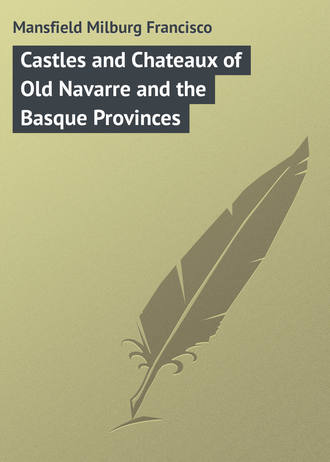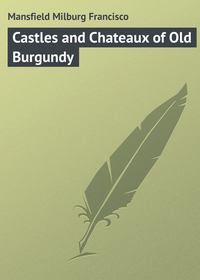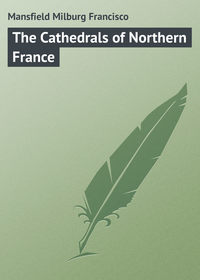 полная версия
полная версияCastles and Chateaux of Old Navarre and the Basque Provinces
The Nivelle is a tiny stream which comes to light on Spanish soil, over the crest of the Pyrenees, and flows rapidly down to the sea at Saint-Jean-de-Luz, on the shores of the Gulf of Gascony.
The Ministry for the Interior in France classes all these chief rivers as flottable for certain classes of boats and barges through a portion of their length, and each of them as navigable for a few leagues from the sea.
Four great “Routes Nationales” cross the Basses-Pyrénées. They are the legitimate successors of the “Routes Royales” of monarchial days. The “Route Royale de Paris à Madrid, par Vittoria et Burgos,” the very same over which Charles Quint travelled to Paris, via Amboise, as the guest of François Premier, passes via Bayonne and Saint-Jean-de-Luz. It is a veritable historic highway throughout every league of its length.
The climate of the Basses-Pyrénées is by no means as warm as its latitude would seem to bespeak, the snow-capped Pyrenees keeping the temperature somewhat low. Pau and Luchon in the interior (as well as Bayonne and Biarritz on the coast) seem, curiously enough, to be somewhat milder than the open country between. The Pyrenees, though less overrun and less exploited than the Alps, are not an unknown world to be ventured into only by heroes and adventurers. They are what the French call a “new world” lively in aspect, infinitely varied, and as yet quite unspoiled, take them as a whole. This is a fact which makes the historical monuments and souvenirs of the region the more appealing in interest, particularly to one who has “done” the conventionally overrun resorts of the Tyrol, Egypt or Norway; and the country here is far more accessible. Furthermore the comforts of modern travel, as regards palace hotels and sleeping-cars, if less highly developed, are more to be remarked. One lives bountifully throughout the whole of the French slopes of the Pyrenees, from a table well supplied with many exotic articles of food such as truffles, and salaisons of all sorts, fresh mountain lake trout, and those delightful crouchades and cassoulets, which in the more populous centres are only occasional, expensive luxuries.
Both the valleys and the mountains are equally charming and characteristic. The lowlanders and the mountaineers are two different species of man, but they both join hands in the admiration of, and devotion to their beloved country.
The soft, sloping valleys and the plains below, in the great watersheds of the Garonne, the Aude, the Nive, or the Adour, tell one story, and the terre debout, as the French geographers call the mountains, quite another. The contrast and juxtaposition of these two topographical aspects, the varying manners and customs of the peoples, and the picturesque framing given to the châteaux and historic sites make an undeniably appealing ensemble which the writer thinks is not equalled elsewhere in travelled Europe.
One of the chief characteristics of the chain of the Pyrenees is that it possesses numerous passages or passes at very considerable elevations, being outranked by surrounding peaks usually to the extent of a thousand metres only. These passes are not always practicable for wheeled traffic to be sure, but still they form a series of exits and entrances from and into Spain which are open to the dwellers in the high valleys of either country on foot or on donkey back. They are distinguished by various prefixes such as puerto, collada, passo, hourque, hourquette, brèche, port, col, and passage, but one and all answer more or less specifically to the name of a mountain pass.
The expression of “il y a des Pyrénées,” has been paraphrased in latter days as “il n’y a plus de Pyrénées.” A Spanish aeronaut has recently crossed the crest of the range in a balloon, from Pau to Grenada – seven hundred and thirty kilometres as the birds fly. This intrepid sportsman, in his balloon “El Cierzo,” crossed the divide in the dead of night, at an elevation varying between two thousand three hundred and two thousand nine hundred metres, somewhere between the Pic d’Anie and the Pic du Midi d’Ossau. In these days when automobiles beat express trains, and motor-boats beat steamships for speed, this crossing of the Pyrenees by balloon stands unique in the annals of sport.
The crossing of the Pyrenees has already resolved itself into a momentous economic question. Half a dozen roads fit for carriage traffic, and two gateways by which pass the railways of the east and west coasts, are the sole practicable means of communication between France and Spain.
The chain of the Pyrenees from west to east presents nearly a uniform height; its simplicity and uniformity is remarkable. It is a veritable wall.
To-day the Parisian journals are all printing scare-heads, reading, “Plus de Pyrénées” and announcing railway projects which will bring Paris and Madrid within twenty hours of each other, and Paris and Algiers within forty. New tunnels, or ports, to the extent of five in place of two, are to be opened, and if balloons or air-ships don’t come to supersede railways there will be a net-work of iron rails throughout the upper valleys of the Pyrenees as there are in Switzerland.
The ville d’eaux, or watering-places, of the Pyrenees date from prehistoric times. At Ax-les-Thermes there has recently been discovered a tank buried under three metres of alluvial soil, and dating from the bronze age.
Old maps of these parts show that the baths and waters of the region were widely known in mediæval times. It was not, however, until the reign of Louis XV that the “stations” took on that popular development brought about by the sovereigns and their courts who frequented them.
Not all of these can be indicated or described here but the accompanying map indicates them and their locations plainly enough.
Nearly every malady, real or imaginary (and there have been many imaginary ones here, that have undergone a cure), can be benefited by the waters of the Pyrenees. Only a specialist could prescribe though.
In point of popularity as resorts the baths and springs of the Pyrenees rank about as follows: Eaux-Bonnes, Eaux-Chaudes, Cauterets, St. Sauveur, Barèges, Bagnères de Bigorre, Luchon, Salies de Béarn, Ussat, Ax-les-Thermes, Vernet and Amélie les Bains.
Whatever the efficacy of their waters may be, one and all may be classed as resorts where “all the attractions” – as the posters announce – of similar places elsewhere may be found, – great and expensive hotels, tea shops, theatres, golf, tennis and “the game.” If the waters don’t cure, one is sure to have been amused, if not edified. The watering-places of the Pyrenees may not possess establishments or bath houses as grand or notorious as those of Vichy, Aix, or Homburg, and their attendant amusements of sport and high stakes and cards may not be the chief reason they are patronized, but all the same they are very popular little resorts, with as charming settings and delightful surroundings as any known.
At Eaux-Bonnes there are four famous springs, and at Eaux-Chaudes are six of diverse temperatures, all of them exceedingly efficacious “cures” for rheumatism. At Cambo – a new-found retreat for French painters and literary folk – are two sources, one sulphurous and the other ferruginous. Mostly the waters of Cambo are drunk; for bathing purposes they are always heated. Napoleon first set the pace at Cambo, but its fame was a long while becoming widespread. In 1808 the emperor proposed to erect a military hospital here, and one hundred and fifty thousand francs were actually appropriated for it, but the fall of the Empire ended that hope as it did many others. In the commune of Salies is a source, a fontaine, which gives a considerable supply of salt to be obtained through evaporation; also in the mountains neighbouring upon Saint-Jean-Pied-de-Port, and in the Arrondissement of Mauléon, are still other springs from which the extraction of salt is a profitable industry.
In the borders of the blue Gave de Pau, in full view of the extended horizon on one side and the lowland plain on the other, one appreciates the characteristics of the Pyrenees at their very best.
One recalls the gentle hills and vales of the Ile de France, the rude, granite slopes of Bretagne, the sublime peaks of the Savoian Alps, and all the rest of the topographic tableau of “la belle France,” but nothing seen before – nor to be seen later – excels the Pyrenees region for infinite variety. It is truly remarkable, from the grandeur of its sky-line to the winsomeness and softness of its valleys, peopled everywhere (always excepting the alien importations of the resorts) with a reminiscent civilization of the past, with little or no care for the super-refinements of more populous and progressive regions. The Pyrenees, as a whole, are still unspoiled for the serious-minded traveller. This is more than can be said of the Swiss Alps, the French Riviera, the German Rhine, or the byways of merry England.
CHAPTER IV
THE PYRENEES – THEIR HISTORY AND PEOPLES
IT may be a question as to who discovered the Pyrenees, but Louis XIV was the first exploiter thereof – writing in a literal sense – when he made the famous remark “Il y a des Pyrénées.” Before that, and to a certain extent even to-day, they may well be called the “Pyrénées inconnues,” a terra incognita, as the old maps marked the great desert wastes of mid-Africa. The population of the entire region known as the Pyrénées Françaises is as varied as any conglomerate population to be found elsewhere in France in an area of something less than six hundred kilometres.
The Pyrenees were ever a frontier battle-ground. At the commencement of the eleventh century things began to shape themselves north of the mountain chain, and modern France, through the féodalité, began to grow into a well-defined entity.
Charles Martel it was, as much as any other, who made all this possible, and indeed he began it when he broke the Saracen power which had over-run all Spain and penetrated via the Pyrenean gateways into Gaul.
The Iberians who flooded southern Gaul, and even went so far afield as Ireland, came from the southwestern peninsula through the passes of the Pyrenees. They were of a southern race, in marked distinction to the Franks and Gauls. Settling south of the Garonne they became known in succeeding generations as Aquitains and spoke a local patois, different even from that of the Basques whom they somewhat resembled. The Vascons, or Gascons, were descendants of this same race, though perhaps developed through a mixture of other races.
Amidst the succession of diverse dominations, one race alone came through the mill whole, unscathed and independent. These were the Basques who occupied that region best defined to-day as lying around either side of the extreme western frontier of France and Spain.
A French savant’s opinion of the status of this unique province and its people tells the story better than any improvisation that can be made. A certain M. Garat wrote in the mid-nineteenth century as follows: —
“Well sheltered in the gorges of the Pyrenees, where the Gauls, the Francs and the Saracens had never attacked their liberties, the Basques have escaped any profound judgments of that race of historians and philosophers which have dissected most of the other peoples of Europe. Rome even dared not attempt to throttle the Basques and merge them into her absorbing civilization. All around them their neighbours have changed twenty times their speech, their customs and their laws, but the Basques still show their original characters and physiognomies, scarcely dimmed by the progress of the ages.”
Certainly they are as proud and noble a race as one remarks in a round of European travel.
A Basque will always tell you if you ask him as to whether he is French or Spanish: “Je ne suis pas Français, je suis Basque; je ne suis Espagnol, je suis Basque; ou, – tout simplement, je suis homme.”
This is as one would expect to find it, but it is possible to come across an alien even in the country of the Basque. On interrogating a smiling peasant driving a yoke of cream-coloured oxen, he replied: “Mais je ne suis pas Basque; je suis Périgourdin– born at Badefols, just by the old château of Bertrand de Born the troubadour.”
One may be pardoned for a reference to the cagots of the Basque country, a despised race of people not unlike the cretins of the Alps. As Littré defines them they are distinctly a “people of the Pyrenees.” The race, as a numerous body, practically is extinct to-day. They lived in poor, mean cabins, far from the towns and under the protection of a seigneurial château or abbey. All intercourse with their neighbours was forbidden, and at church they occupied a space apart, had a special holy water font, and when served with blessed bread it was thrown at them as if they were dogs, and not offered graciously.
This may have been uncharitable and unchristianlike, but the placing of separate holy water-basins in the churches was simply carrying out the principle of no intercourse between the Basques and the cagots, not even between those who had become, or professed to be Christians. “The loyal hand of a Basque should touch nothing that had previously been touched by a cagot.”
From the Basque country, through the heart of the Pyrenees, circling Béarn, Navarre and Foix, to Roussillon is a far cry, and a vast change in speech and manners.
Life in a Pyrenean village for a round of the seasons would probably cure most of the ills that flesh is heir to. It may be doubtful as to who was the real inventor of the simple life – unless it was Adam – but Jean Jacques Rousseau was astonished that people did not live more in the open air as a remedy against the too liberal taking of medicine.
“Gouter la liberté sur la montagne immense!” This was the dream of the poet, but it may become the reality of any who choose to try it. One remarks a certain indifference among the mountaineers of the Pyrenees for the conventions of life.
The mountaineer of the Pyrenees would rather ride a donkey than a pure bred Arab or drive an automobile. He has no use for the proverb: —
“Honourable is the riding of a horse to the rider,But the mule is a dishonour and a donkey a disgrace.”When one recalls the fact that there are comparatively few of the bovine race in the south of France, more particularly in Languedoc and Provence, he understands why it is that one finds the cuisine à l’huile d’olive– and sometimes huile d’arachide, which is made from peanuts, and not bad at that, at least not unhealthful.
In the Pyrenees proper, where the pasturage is rich, cattle are more numerous, and nowhere, not even in the Allier or Poitou in mid-France, will one find finer cows or oxen. Little, sure-footed donkeys, with white-gray muzzles and crosses down their backs, and great cream-coloured oxen seem to do all the work that elsewhere is done by horses. There are ponies, too, – short-haired, tiny beasts, – in the Pyrenees, and in the summer months one sees a Basque or a Béarnais horse-dealer driving his live stock (ponies only) on the hoof all over France, and making sales by the way.
The Mediterranean terminus of the Pyrenees has quite different characteristics from that of the west. Here the mountains end in a great promontory which plunges precipitately into the Mediterranean between the Spanish province of Figueras and the rich garden-spot of Roussillon, in France.
French and Spanish manners, customs and speech are here much intermingled. On one side of the frontier they are very like those on the other; only the uniforms of the officialdom made up of douaniers, carabineros, gendarmes and soldiers differ. The type of face and figure is the same; the usual speech is the same; and dress varies but little, if at all. “Voilà! la fraternité Franco-Espagnole”.
One ever-present reminder of two alien peoples throughout all Roussillon is the presence of the châteaux-forts, the walled towns, the watch-towers, and defences of this mountain frontier.
The chief characteristics of Roussillon, from the seacoast plain up the mountain valleys to the passes, are the château ruins, towers and moss-grown hermitages, all relics of a day of vigorous, able workmen, who built, if not for eternity, at least for centuries. In the Pyrénées-Orientales alone there are reckoned thirty-five abandoned hermitages, any one of which will awaken memories in the mind of a romantic novelist which will supply him with more background material than he can use up in a dozen mediæval romances. And if he takes one or more of these hallowed spots of the Pyrenees for a setting he will have something quite as worthy as the overdone Italian hilltop hermitage, and a good deal fresher in a colour sense.
The strategic Pyrenean frontier, nearly six hundred kilometres, following the various twistings and turnings, has not varied in any particular since the treaty of the Pyrenees in 1659. From Cap Cerbère on the Mediterranean it runs, via the crests of the Monts Albères, up to Perthus, and then by the crests of the Pyrénées-Orientales, properly called, up to Puigmal; and traversing the Sègre, crosses the Col de la Perche and passes the Pic Nègre, separating France from the Val d’Andorre, crosses the Garonne to attain the peaks of the Pyrénées-Occidentales, and so, via the Forêt d’Iraty, and through the Pays Basque, finally comes to the banks of the Bidassoa, between Hendaye and Irun-Feuntarrabia.
The Treaty of Verdun gave the territory of France as extending up to the Pyrenees and beyond (to include the Comté de Barcelone), but this limit in time was rearranged to stop at the mountain barrier. The graft didn’t work! Roussillon remained for long in the possession of the house of Aragon, and its people were, in the main, closely related with the Catalans over the border, but the Treaty of the Pyrenees, in 1659, definitely acquired this fine wine-growing province for the French.
The frontier of the Pyrenees is much better defended by natural means than that of the Alps. For four hundred kilometres of its length – quite two-thirds of its entirety – the passages and breaches are inaccessible to an army, or even to a carriage.
From the times of Hannibal and Charlemagne up to the wars of the Empire only the extremities have been crossed for the invasion of alien territory. It is in these situations that one finds the frontier fortresses of to-day; at Figueras and Gerone in Spain; in France at Bellegarde (Col de Perthus), Prats-de-Mollo, Mont Louis, Villefranche and Perpignan, in the east; and at Portalet, Navarrino, Saint-Jean-Pied-de-Port (guarding the Col de Ronçevaux) and Bayonne in the west. Bayonne and Perpignan guard the only easily practicable routes (Paris-Madrid and Paris-Barcelona).
Hannibal and Charlemagne are the two great names of early history identified with the Pyrenees. Hannibal exploited more than one popular scenic touring ground of to-day, and for a man who is judged only by his deeds – not by his personality, for no authentic portrait of him exists, even in words – he certainly was endowed with a profound foresight. Charlemagne, warrior, lawgiver and patron of letters, predominant figure of a gloomy age, met the greatest defeat of his career in the Pyrenees, at Ronçevaux, when he advanced on Spain in 778.
Close by the Cap Cerbère, where French and Spanish territory join, is the little town and pass of Banyuls. This Col de Banyuls was, in 1793, the witness of a supreme act of patriotism. The Spaniards were biding their time to invade France via Roussillon, and made overtures to the people of the little village of Banyuls – famous to-day for its vins de liqueur and not much else, but at that time numbering less than a thousand souls – to join them and make the road easy. The procureur du roi replied simply: “Les habitants de Banyuls étant français devaient tous mourir pour l’honneur et l’indépendance de la France.”
Three thousand Spaniards thereupon attacked the entire forces of the little commune – men, women and children – but finding their efforts futile were forced to retire. This ended the “Battle of Banyuls,” one of the “little wars” that historians have usually neglected, or overlooked, in favour of something more spectacular.
On the old “Route Royale” from Paris to Barcelona, via Perpignan, are two chefs-d’œuvre of the mediæval bridge-builder, made before the days of steel rails and wire ropes and all their attendant ugliness. These are the Pont de Perpignan over the Basse, and the Pont de Céret on the Tech, each of them spanning the stream by one single, graceful arch. The latter dates from 1336, and it is doubtful if the modern stone-mason could do his work as well as he who was responsible for this architectural treasure.
One finds a bit of superstitious ignorance once and again, even in enlightened France of to-day. It was not far from here, on the road to the Col de Banyuls, that we were asked by a peasant from what country we came. He was told by way of a joke that we were Chinese. “Est-ce loin?” he asked. “Deux cents lieues!” “Diable! c’est une bonne distance!” One suspects that he knew more than he was given credit for, and perhaps it was he that was doing the joking, for he said by way of parting: “Ma foi, c’est bien triste d’être si loin de votre mère.”
What a little land of contrasts the region of the Pyrenees is! It is all things to all men. From the low-lying valleys and sea-coast plains, as one ascends into the upper regions, it is as if one went at once into another country. Certainly no greater contrast is marked in all France than that between the Hautes-Pyrénées and the Landes for instance.
The Hautes-Pyrénées of to-day was formerly made up of Bigorre, Armagnac and the extreme southerly portion of Gascogne. Cæsar called the people Tarbelli, Bigerriones and Flussates, and Visigoths, Franks and Gascons prevailed over their destinies in turn.
In the early feudal epoch Bigorre, “the country of the four valleys,” had its own counts, but was united with Béarn in 1252, becoming a part of the patrimony which Henri Quatre brought ultimately to the crown of France.
Antiquities before the middle ages are rare in these parts, in spite of the memories remaining from Roman times. Perhaps the greatest of these are the baths and springs at Cauterets, one of them being known as the Bains des Espagnoles and the other as the Bains de Cesar. These unquestionably were developed in Roman times.
The chief architectural glory of the region is the ancient city of St. Bertrand, the capital of Comminges, the ancient Lugdunum Convenarum of Strabon and Pliny. Its fortifications and its remarkable cathedral place it in the ranks with Carcassonne, Aigues-Mortes and Béziers.
The manners and customs of the Bigordans of the towns (not to be confounded with the Bigoudens of Brittany) have succumbed somewhat to the importation of outside ideas by the masses who throng their baths and springs, but nevertheless their main characteristics stand out plainly.
Quite different from the Béarnais are the Bigordans, and, somewhat uncharitably, the latter have a proverb which given in their own tongue is as follows: – “Béarnès faus et courtès.” Neighbourly jealousy accounts for this. The Béarnais are morose, steady and commercial, the Bigordans lively, bright and active, and their sociability is famed afar.
In the open country throughout the Pyrenees, there are three classes of inhabitants, those of the mountains and high valleys, those of the slopes, and those of the plains. The first are hard-working and active, but often ignorant and superstitious; the second are more gay, less frugal and better livers than the mountaineers; and those of the plains are often downright lazy and indolent. The mendicant race, of which old writers told, has apparently disappeared. There are practically no beggars in France except gypsies, and there is no mistaking a gypsy for any other species.
In general one can say that the inhabitants of the high Pyrenees are a simple, good and generous people, and far less given to excess than many others of the heterogeneous mass which make up the population of modern France.











